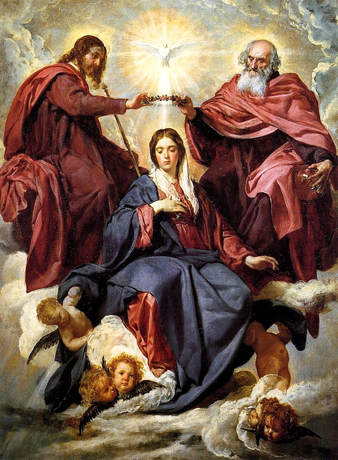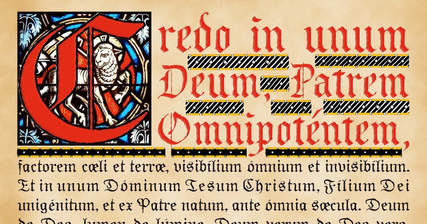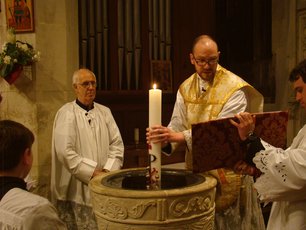|
Text: John 6:60-69
‘After this, many of his disciples left him and stopped going with him.’ (John 6:66) We often read together stories from the gospel where the Lord Jesus is revered, sought by many, and listened to. When we hear of opposition, this generally comes from outside, from the people who do not accept him and look for to his demise. John 6 – which we finish today – has so far fitted into these parameters. Jesus has worked miracles, he has been pursued by the crowd who even wanted to make him king by force (Cf. John 6:15), he has taught countless people and he has revealed himself as ‘the living bread that came down from heaven’ (John 6:51). Whilst opposition has come from the usual places and it was summarised last week in a simple question, ‘How can this man give us his flesh to eat?’ (John 6:52). However, as we reach the end of the Bread of Life discourse we encounter something different – an unexpected turn of events where both openness and opposition to Jesus come from among the same group, from among his disciples. The reading picks up from where we left it last week and says, ‘After hearing his doctrine many of the followers of Jesus said, “This is intolerable language. How could anyone accept it?”’ (John 6:60). The disciples hear Jesus saying ‘my flesh is real food and my blood is real drink’ (John 6:55), they hear him talk of his body as the Bread which give life to the world (Cf. John 6:51), and they are stunned by these words. A rift opens among them. On one side, many disciples – not one or two, but “many” – are sceptic about how Jesus could ever give his own self as food, and they brand his teaching as “intolerable language” – in other translations this is rendered as “unacceptable saying”, or a “hard teaching”… On the other side, we have Peter and the other eleven disciples – whom, far from being perfect, trust in the Lord’s word and remain with him. The rift among the disciples hangs on this; Jesus said, ‘Very truly, I tell you... Those who eat my flesh and drink my blood have eternal life, and I will raise them up on the last day; for my flesh is true food and my blood is true drink’ (John 6:53-55). Think about it. Of course this is could be seen as an unacceptable saying. Many disciples thought they were following a religious leader who would have restored freedom to the people of Israel with his revolutionary ideas. But what they hear now from him is a speech about giving himself up as food and drink to those who believe… What on Earth could this even mean? As a consequence, the gospel tells us, a good number of disciples leave Jesus – they literally do the opposite of conversion; they turn away from him – and stop travelling with him. The words of Jesus plunge disciples into crisis, and still to this day the Bread of Life discourse is the stumbling block for many Christians. The teaching about the Sacrament of the Eucharist, about Jesus’ Body and Blood, has become a visible rift within the Church for the last 500 years at least – but it has been present since the very beginning. The fact that Jesus is present on our altars with his Body and Blood, Soul and Divinity is an unacceptable doctrine for many but the cause of hope, consolation, and joy for others. It all depends what side of the divide we decide to go for. ‘The Eucharist is the place where one comes to eternal life. Encountering the broken flesh and the spilled blood of Jesus, “lifted up” on the cross (vv. 53-54), [we] called to make a decision for or against the revelation of God in that encounter (vv. 56-58), gaining or losing life because of it (vv. 53-54)’ (F.J. Moloney, The Gospel of John, p. 224). The words of Jesus may be a difficult saying to understand, but that should not be an obstacle to faith. Jesus calls us to believe in him and in the mystery of his Body and Blood, not to have a PhD in sacramental theology. Therefore, when he says to us ‘my flesh is true food and my blood is true drink’ we have a straightforward choice. We can stubbornly rely on ourselves and our cynicism, believing only what we can prove or understand (like the many disciples did), or we can courageously embrace the faith, aiming to rely solely on the Lord Jesus and on his words no-matter-what – never ever letting go of him. It could be that the Lord Jesus is addressing us today as he did to the Twelve, ‘What about you, do you want to go away too?’ (John 6:67). But, through Saint Peter, the gospel gives us the words with which we should answer him. Kneeling at the altar rail to receive the Body and Blood of Christ it is as if we were saying, ‘Lord, who shall we go to? You have the message of eternal life’ (John 6:67).
0 Comments
 By Father Diego Galanzino SMMS Revelation/Apocalypse 11:19,12:1-6,10 - Psalm 44(45):10-12,16 ‘On your right stands the Queen in gold of Ophir.’ Psalm 44(45):10 If we opened our Bibles and searched through their many pages we would not find a straightforward description of what we celebrate today; the Scriptures do not give us an account of how the Mother of God was taken up body and soul into heaven.. What we would find instead are scattered clues, glimpses, and prophecies about the Assumption; clues, glimpses, and prophecies which have lead the Church to affirm that at the end of her earthly life Mary was assumed into heaven (and so was preserved from the decay of the tomb) to be with her Son, Our Lord Jesus Christ, and to be crowned a Queen of all creation. But it is not all plain sailing. Even though the Assumption has been celebrated by since the 4th or 5th century, it has caused many debates among Christians; and that, which should be the cause of rejoicing for each and every Christian, has often ended up being as a serious bone of contention. Having said this, I don’t think that either Mary in herself, or the belief that she was taken up to heaven are the true reasons for debates and divisions. She who is mother of all believers cannot be the source of quarrelling among her children. Rather, I think that opposition the Assumption of Mary springs from two deeply-engrained misunderstandings many Christians have about faith. The first misunderstanding is essentially a corruption of the traditional belief that the Scriptures contain everything that is necessary to Salvation. It says that Christians should sign up, as it were, only to those matters of faith that are readily and explicitly proposed in the Bible – those things which are plainly laid out in the Scriptures and nothing else. The Assumption of Mary is not in any book, so it cannot possibly be a matter of faith – indeed, for a few Christians, it cannot possibly be real, period. Yet, we believe that the Lord Jesus promised to his Church that the Holy Spirit would lead us in understanding all truth (Cf. John 16:13) – “all truth”, even those things which the Scriptures reveal only through clues, glimpses, and prophecies; those things and that need some prayerful reasoning to be understood. So it is with the Assumption. It is the Holy Spirit who speaks to interpret the Scriptures. It is him who leads believers in piecing together clues, glimpses, and prophecies to understand the mystery… For example, let us look at today’s readings. It is the Holy Spirit who tells us that, when Psalm 45 describes the coronation procession of an Old Testament princess, it is really pointing forward to the entrance of Mary into heaven and to her coronation as Queen of all creation. It is the Holy Spirit who tells us that in our first reading the ‘ark of the covenant’ found in the heavenly sanctuary (Rev/Ap. 11:19), and the ‘woman clothed with the Sun’ (Rev/Ap. 12:1) are both images of the true ark of the New Covenant, the Mother of God in heavenly glory. And, again, it is the Holy Spirit who tells us that Mary’s words, ‘from this day forward all generations will call me blessed’ (Cf. Luke 1:48), are completely fulfilled the moment she set foot in heaven, the true home of the blessed. The second misconception is rather more insidious than the first, and certainly more difficult to eradicate. It concerns the person of Mary as a woman, and with her, perhaps every leading woman in the Scriptures. Let me explain. If we opened our Bibles we would see that, actually, ascending or being taken up to heaven is not something completely unheard of. Three examples come to mind. Early in the Biblical narrative, Adam and Eve’s great-great-great-great-great-(I think!)grandson, Enoch, is assumed into heaven because of his spotless way of life. Angels pick him up and take him to be with God (Gen. 5:24) – in a few medieval illustrations Enoch is dragged upward by his hair… This event was so astounding that it is recounted even in the New Testament; the Letter to the Hebrews says ‘By faith Enoch was taken up so that he should not see death, and “he was found no more because God had taken him’ (Heb.11:5). Later on, in the second book of Kings, it is the turn of the great prophet Elijah to be assumed into heaven in style; he rides upwards towards paradise carried on a chariot of fire (Cf. 2Kings 2:11) provided by God. Finally, Jesus ascends to heaven after his Resurrection. He is not carried there; he goes to the Father out of his own divine power, taking with him our human nature and opening the way for all believers to be with him at the heart of God (Cf. Luke 24:50-53). Let us consider for a moment these examples in which human beings have ascended or were taken up to heaven before Mary. Enoch, Elijah, the Lord Jesus. Heaven is starting to look like an old boys club. I jest, I know, but these examples illustrate very well a male-dominated misunderstanding whereby a few Christians believe that God acts through, exalts, and rewards only men. Belief in the Assumption of Our Lady shatters this misinterpretation. The Assumption shows us that God acts through, exalts, and rewards everyone whom he freely chooses – regardless of whom they are. Mary cooperated with God’s new creation like no other human before her (‘let it be so’ she said to the Angel Luke 1:38); she brought God’s Son into the world; she emotionally suffered with him on Calvary; she stood by him even as her soul was pierced by a sword; and she gathered the disciples around her in prayerful anticipation of Pentecost. It is only right that a woman who, through the grace of God, participated so closely in the work of redemption, should be the first to experience the fruits of redemption – the life of heaven. So, if we let go of our misconceptions in order to embrace true faith, what would the Assumption of Our Lady have to say to us? It is a token of our future. It is a sign of hope for all who believe is Christ, a cause of joy for all who struggle through life, a sign of consolation when we encounter sorrows. Our blessed mother is in heaven, free from the corruption of the grave, and from there she helps us with her prayers, guides us with her love, and cheer us on as we too journey home. Virgin Mother, Mary blessed, raised on high and crowned with grace, May your Son, the world's redeemer, grant us all to see his face. Amen.  Mark 5:21-43 One of the synagogue officials came up, Jairus by name, and seeing him, fell at his feet and pleaded with him earnestly. (Mark 5:22) This morning’s gospel could be interpreted in different ways. For example, the connection which the lectionary makes between the reading from the book of Wisdom and Mark 5 highlights the fact the death and illness are not part of God’s design for creation, and that as a consequence God destroys these conditions every time he meets them in Christ. Instead, I would like to reflect with you on a broader theme which runs through the whole story; the theme of faith in the Lord Jesus. Mark introduces two characters who approach Jesus to find healing; their situations are desperate and it would be easy to think that they both have lost all hope and so they go to Jesus thinking “Well, what do I have to lose!” But if we look closely to the text we see that this is not the case; and instead each character makes a statement of faith in Christ as soon as they approach the Lord. ‘Do come and lay your hands on her to make her better and save her life.’ (Mark 5:23) says Jairus; and ‘If I can touch even his clothes, I shall be well again.’ (Mark 5:28) says the woman to herself. For both Jairus and the woman faith is manifested by their words of trust in Jesus and by their actions. In other words their faith is manifested by the choice of approaching the Lord and trying to find healing through him. So, both characters give us an idea of what faith is; an assent and affirmation, a willing and intentional “yes” to the person of Jesus Christ and to his ministry. As you probably know, I have never been overly fond of evangelical hymns, but there is one which fits this story very well. It sings, ‘O happy day that fixed my choice on Thee my Saviour and my God’ and indeed, this was a happy day for Jairus and the woman who, by opening the doors to Christ, by willingly and intentionally placing their faith in the Lord Jesus, find in him more than they could have ever hoped for. Certainly, their assent is somehow costly in both cases. Jairus, a synagogue official, has to humble himself before a man who was often at odds with the Jewish establishment, and he must face the peer pressure of more orthodox groups. The woman with the haemorrhage must brave rejection and insults from the crowds who knew her to be ritually unclean due to her illness. Yet, whatever the personal cost they faced at the time, by intentionally placing their faith in the Lord both characters are soon rewarded for their decision; for their choice, as it were. So, how is it with us? Do we express our faith in similar terms? And when is the last time we have knelt and we have made and affirmation of faith like Jairus' and the woman's? When was the last time we said in prayer “Jesus, I trust in you”? In the old rite for the Mass, and in the Book of Common Prayer, when the congregation stands to say or sing the Creed, they begin with the words “I believe in one God”. In this church we say “We believe in one God”. Yet, when we say the Creed, Sunday after Sunday, we often blurt out the words without really thinking about what we are actually doing. The Creed is a powerful affirmation of faith, which should be a weekly renewal of our intentional “yes” to Christ… We stand we assume the posture of those who are ready and willing, and we reaffirm together both our individual and our corporate faith; we place our faith squarely and solely again in the one true God. In a sense, we could say, through the Creed we make a statement of faith much in the same way Jairus and the woman did in the gospel. If we do this in all honesty our faith will be genuinely revived, and we will find in God more than we could have ever hoped for. Each Sunday then, would be the “happy day that fixed our choice on our Saviour and our God”. 2 Corinthians 4:13-5:1
As we have the same spirit of faith that is mentioned in scripture – I believed, and therefore I spoke – we too believe and therefore we too speak. (2 Corinthians 4:13) The passage of 2Corinthians we read this morning opens with an explanation of why St Paul is compelled to speak about faith and about the Lord Jesus in the way he does; faith is so embedded in him and it is such a powerful force that he cannot but write, speak, preach, and labour in every possible way to explain it to others and to bring Jesus to everyone he meets. Paul quotes psalm 116 in its Greek text as his justification – I believed, and therefore I spoke – but he quickly starts to use the plural form to include on just himself, but also every Christian in Corinth, and in turn, to include every Christian soul throughout the ages. We believe, and therefore we speak should be our own justification too for talking about faith and the Lord Jesus to others. It’s easy for someone in a dog-collar to say that we should talk about faith, especially when people expect you to do so, or half-imagine you to be a God-botherer. Sayings such as “Religion should be kept private” and “One shouldn’t talk about politics or religion at the dinner table” are deeply engrained in our society and in the way we do things. So, I know who awkward that might seem for many people in the pews. But the truth of the matter doesn’t change, We believe, and therefore we should speak. And Paul gives a simple and practical pattern for the way everyone should learn to talk about faith. For example, when he speaks about hardships of the body, he is not doing so from a lofty height. He is talking from personal experience. Physically, Paul was not a very healthy person to start with, and even putting aside the persecutions he endured for the faith, the constant travelling, his daily work, and his ministry for the Church, must have frayed his body and tested his endurance to the limit. Yet, he says, that out of personal sufferings comes the knowledge that the Father, who raised Jesus from the dead, is at work within us. And it is out of this vulnerability and frailty we can speak all the more clearly and convincingly about faith. Later on, when Paul compares the human body to a tent fit for our earthly dwelling, he does so from the point of view of a serious traveller and – most of all – as a tent-maker… we know that when the tent in which we live on earth is folded up, there is a house built by God for us… in the heavens (2 Corinthians 5:1). The Apostle is able to draw links between what he does for a living (which in itself isn’t particularly Christian or newsworthy) and his faith; his daily life informs the way he believes and the way he can articulate his faith to others. Then we too could learn from Paul. How does our experience of testing or difficult times can shape the way we talk about faith? how can it encourage others in their trials? and how can our work or various activities ground the faith in our daily lives? But I should say more about today’s readings. Some years ago a priest friend of mine wandered into his central London church only to find that the vestry had been broken into and a few items had been stolen from it. After the usual phone calls to the police and churchwardens he robed and went to the altar to celebrate a midweek Mass only to find, to his complete surprise, that the gospel reading appointed for that day was, ‘Do not store up for yourselves treasures on earth, where moths …destroy, and where thieves break in and steal. But store up for yourselves treasures in heaven …where thieves do not break in and steal.’ (Matthew 6:19-20) As Alanis Morissette would say, ‘Isn’t it ironic?’ Even from personal experience I can testify that such coincidences or clashes between what goes on around us and the lectionary are very common indeed. We could say that they are just mere coincidences, or be grateful to God for pointing us towards his Word at the times when perhaps we most need guidance and consolation. I believe that this is also what is happening today with our readings. Not even a fortnight since Jill’s funeral, the past week has brought fresh sorrows to our church family as Father Colin passed away, but as we come to church to celebrate Mass and to begin a new week together our readings remind us of our faith in the final victory of God over death. In the eyes of the world Jesus looked crushed, broken, and condemned to an undignified death, but through the testimony of the Scriptures and through the eyes of faith we know that his rising from the dead is what gives us hope for the future. Human experience has been radically altered by this. We are given a new, final end for our earthly journeying; that is, as our second reading says, to be “raised and put at the side of the Lord Jesus with the saints” (Cf. 2Cor 4:14). Like St Paul, we may feel the strain of sorrow and the weight of sufferings that we (or our loved ones) have to endure, but we ought to place our faith in and be comforted by the One who ultimately will see that things are made right. So …we know that when the tent in which we live on earth is folded up, there is a house built by God for us… in the heavens (2 Corinthians 5:1).  John 20:1-18 ‘…he saw and he believed. Till this moment they had failed to understand the teaching of scripture, that Jesus must rise from the dead.’ John 20:8-9 Perhaps surprisingly, the gospel reading set for Easter Day presents us with the mystery of the resurrection of the Lord, without featuring Jesus himself. Instead, this passage is marked by frantic search for some tangible explanation for the disappearance of Jesus’ body; there are rumours of something having happened at the tomb overnight, perhaps fears that the resting place of Jesus has been vandalised, that the body has been stolen… There are witness statements to be confirmed, and a certain degree of shock to be overcome. But among all this uncertainty we encounter an example of faith which should help us in our own faith journey. This example is given to us by the Saint John, described in the gospel as the disciple whom Jesus loved. In verses 8 and 9 we are told a peculiar phrase that has puzzled theologians ever since, we are told that John ‘saw and believed; Till this moment [Peter and himself] had failed to understand the teaching of scripture, that [Jesus] must rise from the dead.’ John believed without understanding the Scriptures? Then what did John believe in? Can there be faith without full understanding of the Scriptures? A few Christian writers affirm that the words ‘saw and believed’ mean that John finally believed in what Mary Magdalene about Jesus’ body having been taken from the tomb (Cf. John 20:2). In a world where female witness counted very little, John and Peter run to the tomb to verify Mary’s story; so when John’s sees that the woman was right, he eventually believes in her statement – Jesus’ body is truly gone. However, I would stand with other gospel interpreters in suggesting that John’s faith is actual faith in the resurrection as a mystery; faith in the inexplicable victory of Christ over death. John sees the grave clothes left neatly behind, he recalls the words of Mary, and something clicks in him – this cannot have been the work of very tidy grave robbers. John believes. He may not be able to articulate his faith very well at this stage, but an embryonic faith is already there; a faith which will later be confirmed in his sighting of Jesus – later in the gospel John is the first one of the disciples to recognise Jesus from afar and to shout with joy, ‘It is the Lord!’ (John 21:7). John believes in the very mystery of what happened; he may not be able to explain his faith using Scriptural references, yet he believes. I believe John’s experience may be quite common among Christians. Oftentimes, people think that, as believers, we have everything figured out; that we have the answer to whatever theological question and extreme moral dilemma we might be face by. But the truth is that we don’t; we are works in progress not just in terms of how we behave, but even in terms of how we believe. In this sense, for many Christians having faith in a constant prayer saying, ‘Lord I believe, help my unbelief’ (Mark 9:24), and this is a good place to start. But we go even a step further. For example, this morning we welcome James into the family of the Church, as he comes to the Lord supported by the faith of his parents and godparents, and by the faith of all God’s people in this place. James cannot articulate faith in God, but God accepts our faith, however great or small, on his behalf, and welcomes him in the number of his children. As James’ family, and as a wider congregation, all we need to do next is trying to grow in this faith, along with him, through grace, study, and prayer. Like Saint John, James will have occasions for his faith to mature, be strengthened, and confirmed in his own words; but in the meantime, we just need an open heart to believing and to be constant in prayer. |
Archives
June 2020
Categories
All
|
 RSS Feed
RSS Feed


